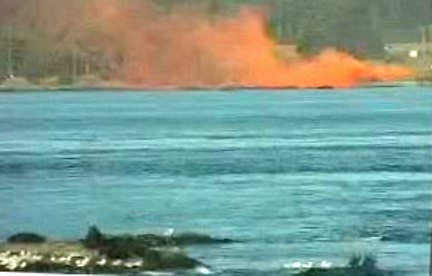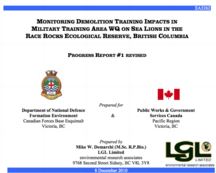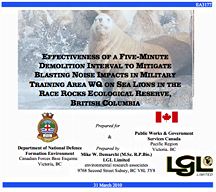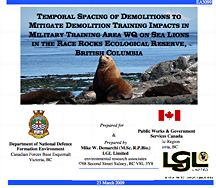DND BLASTING ACTIVITIES AT ROCKY POINT:
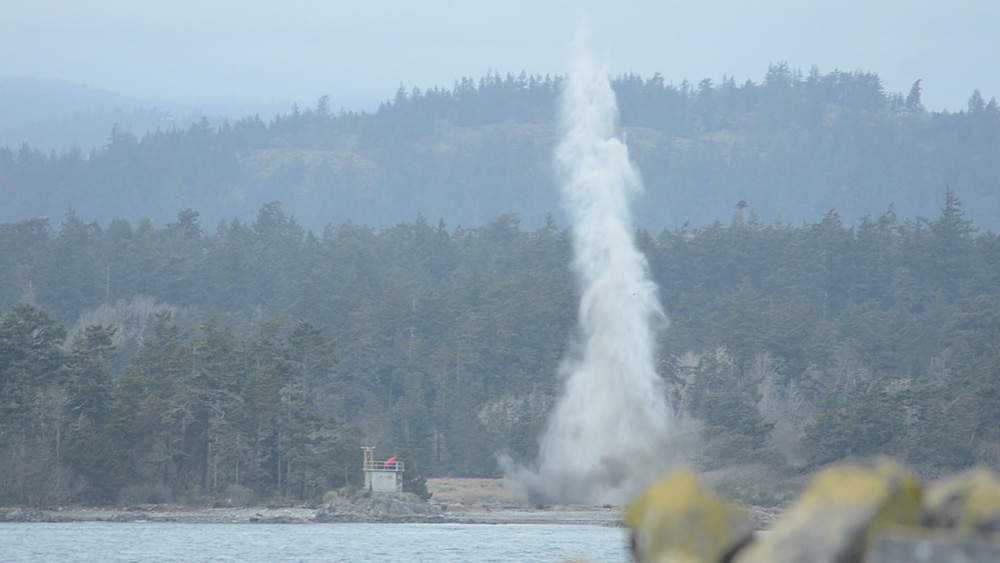 Bentinck island is used by the Department of National Defense as both a demolition range and a testing range for explosives. On the South end of Rocky Point there is a disposal pit where other demolition occurs, and in Whirl Bay, behind Christopher Point, there is an underwater test site. The size of the explosions is supposed to be monitored and controlled , however, we invariable get widely varying impacts. Our ecoguardians have made observations of the impact on sea
Bentinck island is used by the Department of National Defense as both a demolition range and a testing range for explosives. On the South end of Rocky Point there is a disposal pit where other demolition occurs, and in Whirl Bay, behind Christopher Point, there is an underwater test site. The size of the explosions is supposed to be monitored and controlled , however, we invariable get widely varying impacts. Our ecoguardians have made observations of the impact on sea
lions, seals and seabirds over the last few years. Invariably the blasting results in the sea lions being scared from the islands . Sometimes they do come back to haul out on the rocks but they often move on to another location. Unfortunately the location of Race Rocks next to these areas makes it very difficult to mitigate the impact of these explosions.
- See the “Before and After” from the sitezap camera 1- Nov 7,2002
- Link to Fisheries and Oceans Canada file on Guidelines for the Use of Explosives In or Near Canadian Fisheries Waters
- The Race Rocks logs have documented the activities of the military and the effects observed on the animals of Race Rocks
- Summary report: Responses of Steller Sea Lions (Eumetopias jubatus) to In-Air Blast Noise from Military Explosions DEMARCHI, MW AND MD BENTLEY. 2004.
- Effects of natural and human-caused disturbances on marine birds and pinnipeds at Race Rocks, British Columbia. LGL Report EA1569. Prepared for Department of National Defence, Canadian Forces Base Esquimalt and Public Works and Government Services Canada. 103 p.
- This video was made on October 7, 2002 in order to document the effect of the
 Department of National Defence demolition exercises on Bentinck Island on the behaviour of birds and marine mammals at Race Rocks MPA. In previous years we have observed considerable disruption by military exercises involving blasting on nearby Bentinck Island in the fall just after the sea lions have returned to the island. We have requested that blasts be spread out over a longer period of time during an exercise. Traditionally blasts have come in a series of three. The first one would alert the sea lions, the second would send a few in the water and the third would clear the islands. This year on this one occasion, only two blasts were held at five minutes apart. The results are shown in the video.
Department of National Defence demolition exercises on Bentinck Island on the behaviour of birds and marine mammals at Race Rocks MPA. In previous years we have observed considerable disruption by military exercises involving blasting on nearby Bentinck Island in the fall just after the sea lions have returned to the island. We have requested that blasts be spread out over a longer period of time during an exercise. Traditionally blasts have come in a series of three. The first one would alert the sea lions, the second would send a few in the water and the third would clear the islands. This year on this one occasion, only two blasts were held at five minutes apart. The results are shown in the video. - On November 7, 2002, the DND were still doing their demolition blasting exercises at Bentinck Island. (not Oct 7 as stated in this draft version of the video) The students
 from Lester Pearson College who were out for a project week were able to catch the images of the impact of these blasts on the first day from the science centre window and on the second day from the top of the light tower. In the tower, they interviewed Mike Demarchi of LGL who is currently doing a $50,000 contract for the Department of National Defence to monitor the impact of these blasts and to compare them with other disturbances at Race Rocks.
from Lester Pearson College who were out for a project week were able to catch the images of the impact of these blasts on the first day from the science centre window and on the second day from the top of the light tower. In the tower, they interviewed Mike Demarchi of LGL who is currently doing a $50,000 contract for the Department of National Defence to monitor the impact of these blasts and to compare them with other disturbances at Race Rocks.
Update 2020: and its still going on —-https://www.racerocks.ca/tag/blasting/
and on January 27-2020: another set of blasts from Bentinck Island clears the docks of sealions:
https://www.racerocks.ca/wp-content/uploads/2020/01/Blasting.mp4“][/video]
| Recommendations:
1. Explosions should only be conducted at times of the year when there are no nesting birds or harbour and elephant seals having young . 2. During the months of August, September and October when the sea lions are returning to the islands, they are particularly sensitive to disturbances. 3. December, March and April are probably the times of least impact but only if explosion size is carefully controlled. 4. The sizes of explosions should be carefully monitored so as to limit the impact of disturbance. 5. Blasts should be spaced out to at least 10 minutes between detonation, and especially never three blasts in succession. This lessens the impacts on the animals. SAMPLE DAILY LOGS FROM RACE ROCKS WITH EFFECTS OF BLASTING ON ANIMAL BEHAVIOUR Thursday, November 22, 2001–MARINE LIFE: A typical November day weather wise however the Military detonation exercises on Bentinck Island were particularly disturbing for the Harbour Seals and Sea Lions. Once the blasting was done for the day the animals were still quite nervous and in fact when a Cuda Marine Whale Watching boat went by one rock (15:15-15:30) with approximately 120 sea lions hauled out over half of them stampeded into the water!” Thursday, January 17, 2002 Friday, January 18, 2002 Thursday, January 24, 2002 Addendum: |
| UPDATE: January, 2007: Recent blasting activities at Bentinck Island have flushed some of the birds and have scared some of the northern sea lions into the water. In general however we have observed that when they only do two blasts at more than a 1 minute interval, there is much less disturbance than three successive blasts. |
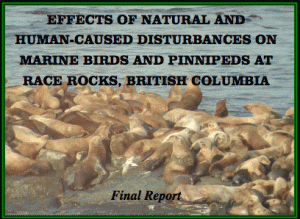 DEMARCHI, MW AND MD BENTLEY. 2004. Effects of natural and human-caused disturbances on marine birds and pinnipeds at Race Rocks, British Columbia. LGL Report EA1569. Prepared for Department of National Defence, Canadian Forces Base Esquimalt and Public Works and Government Services Canada. 103 p. DEMARCHI, MW AND MD BENTLEY. 2004. Effects of natural and human-caused disturbances on marine birds and pinnipeds at Race Rocks, British Columbia. LGL Report EA1569. Prepared for Department of National Defence, Canadian Forces Base Esquimalt and Public Works and Government Services Canada. 103 p.
Note in particular, the discussion of the results concerning the effects of blasting on the behaviour of sea lions.
|
